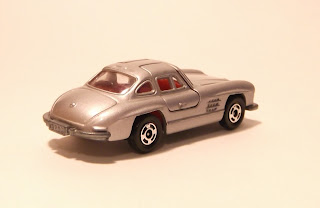A blog focusing on 1/64 diecast from such popular brands as Hot Wheels, Matchbox, Johnny Lightning, M2 Machines, GreenLight, Tomica, Yat Ming, Majorette, MotorMax, Siku, Corgi, Guisval, Playart, Ertl, Zylmex, Racing Champions, & many more. Swifty's Garage features a daily Car Of The Day and news updates from your favorite brands!
Wednesday, March 14, 2012
Today's car of the day comes from Firehawk73's collection and is Tomica's Mercedes-Benz 300SL.
The Mercedes-Benz 300SL was introduced in 1954 as a two-seat, closed sports car with distinctive gull-wing doors. Later it was offered as an open roadster. It was the fastest production car of its day.
Built by Daimler-Benz AG and internally numbered W198, the fuel-injected road version was based (somewhat loosely) on the company's highly successful competition-only sports car of 1952, the somewhat less powerful carbureted Mercedes-Benz 300SL (W194).
The road model was suggested by Max Hoffman. Being intended for customers in the booming post-war American market it was introduced at the 1954 New York Auto Show, unlike previous models introduced at either the Frankfurt or Geneva shows. In Mercedes-Benz fashion, the "300" referred to the engine's three litre cylinder displacement. The "SL" stood for "Sport Leicht" (Sport Light).
The 300SL was best known for both its distinctive gull wing doors and being the first-ever four-stroke car equipped with a gasoline direct injection. The gull wing version was available from March 1955 to 1957. Production of the roadster ended in 1963 with the introduction of the 230SL.
For more information and pictures of the real car please visit: Mercedes-Benz 300SL
New York Mercedes distributor Max Hoffman, Daimler-Benz's official importer in the USA, suggested to DBAG management in Stuttgart that a street version of the 300SL would be a commercial success, especially in America.
The racing W194 300SL was built around a tubular chassis to offset its relatively underpowered carbureted engine. Designed by DBAG's chief developing engineer, Rudolf Uhlenhaut, the metal skeleton saved weight while still providing a high level of strength. Its unique architecture gave birth to the model's distinctive gull wing doors, as part of the chassis passed through what would be the lower half of a standard door. Even with the upward opening doors, the 300SL had an unusually high sill, making entry and exit from the car's cockpit problematic. A steering wheel with a tilt-away column was added to improve driver access.
The 300SL's body was mainly steel, except for the aluminum hood, doors and trunk lid. It could also be ordered with an all-aluminium outer skin at tremendous added cost, saving 80 kg (176 lb).
More than 80% of the vehicle's total production of approximately 1400 units were sold in the US, making the Gull wing the first Mercedes-Benz which sold in bulk outside its home market and confirming the validity of Hoffman's suggestion. The 300SL is credited for changing the company's image in America from a manufacturer of solid, but staid, automobiles to that of a producer of sporty cars.
Subscribe to:
Post Comments (Atom)





No comments:
Post a Comment